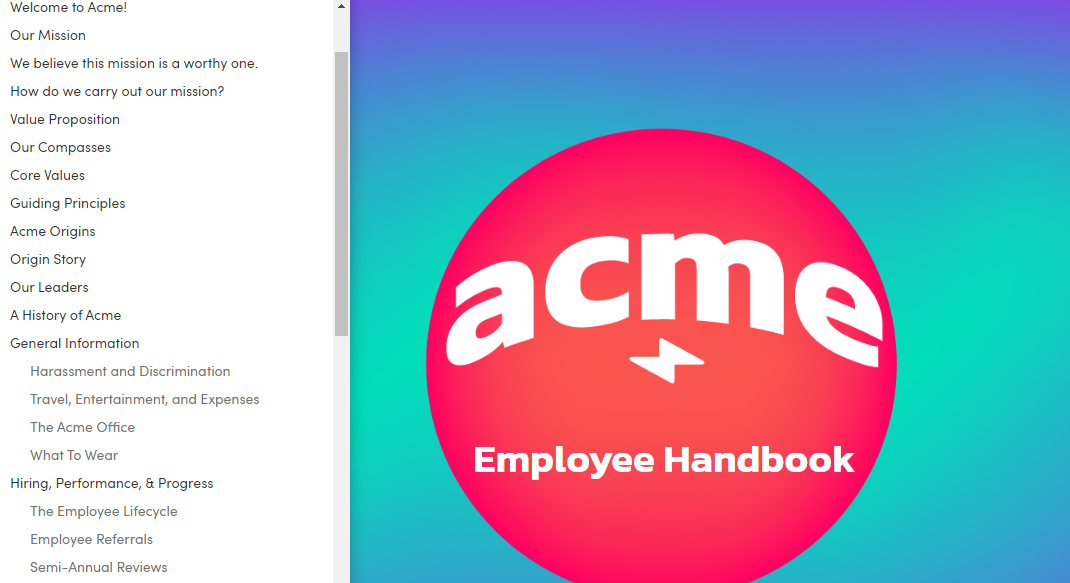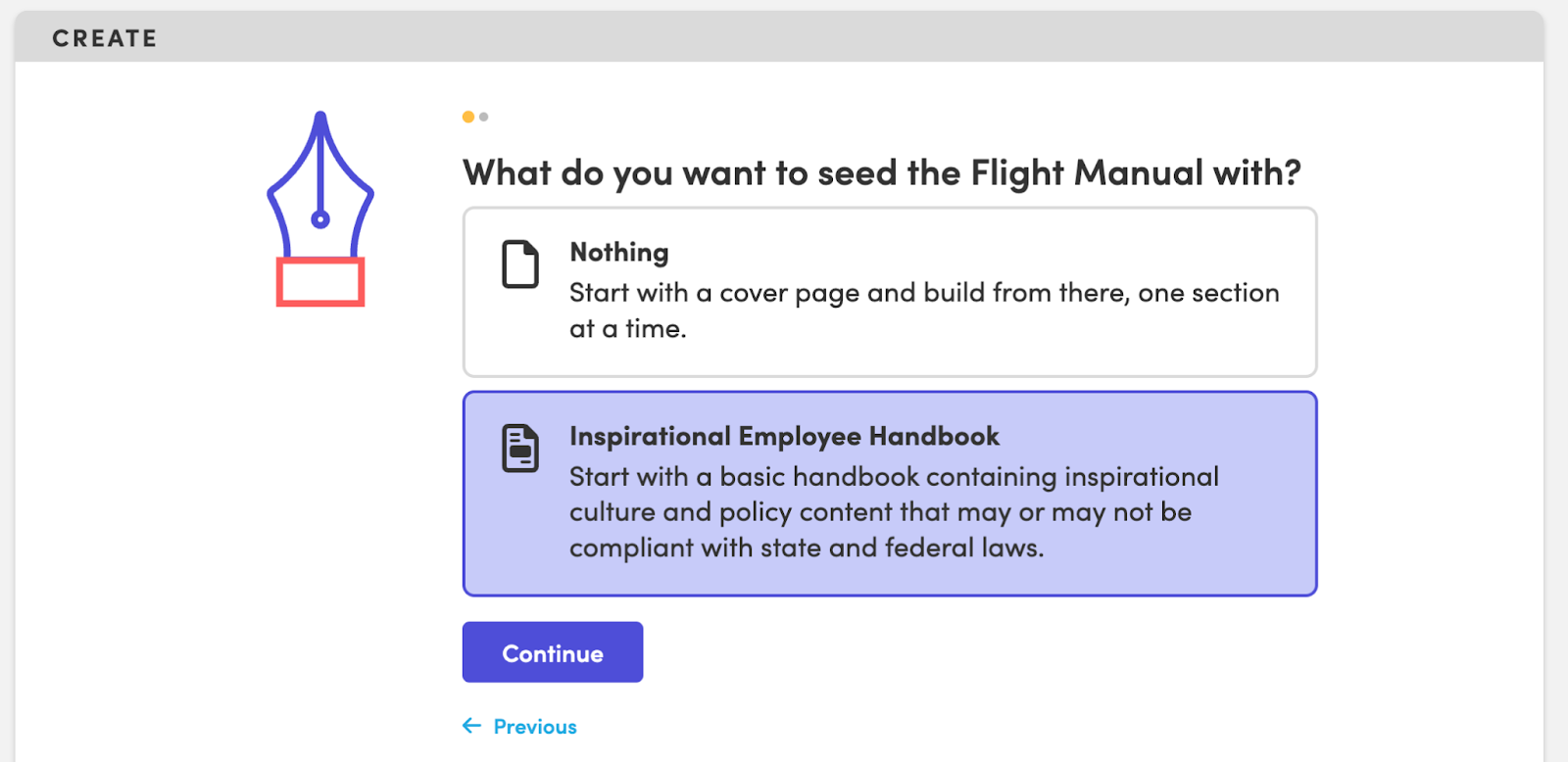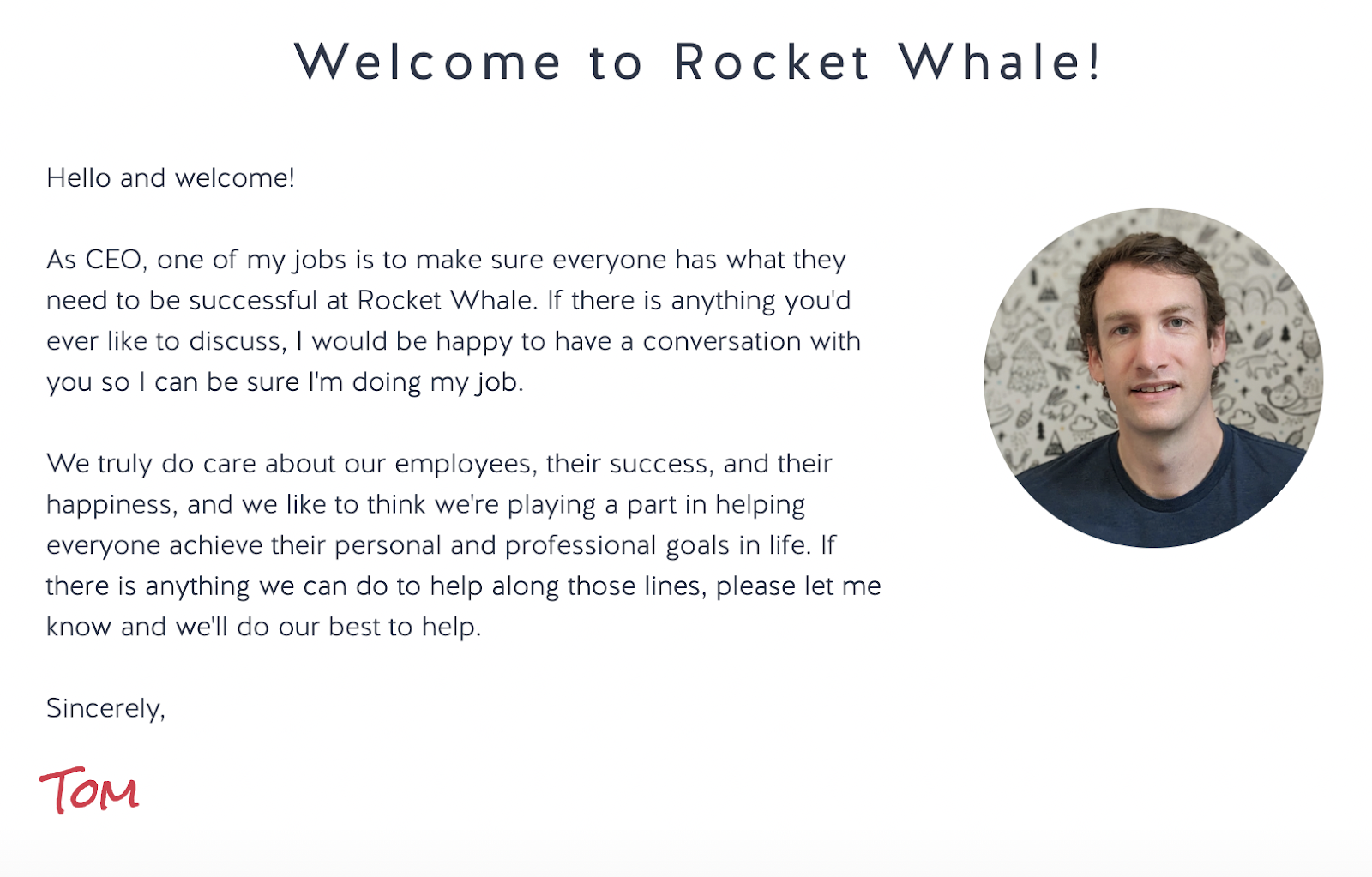How to Collaborate and Get Approvals for Your Employee Handbook
Though you may think of employee handbooks as an HR thing, it’s best to solicit input from various departments, like your executive leadership team, IT, and legal counsel. Collaboration helps ensure your handbook content is accurate and properly reflects your company culture.
So, how do you manage the collaboration and approval process without getting overwhelmed?
How Collaboration Leads to a Better Employee Handbook
When beginning your employee handbook journey, you might be tempted to keep the team as small as possible, hoping it will lead to a more efficient process. No matter how tempting it may be, don’t create your handbook in isolation! Different departments and roles bring unique perspectives to the table, making your handbook more comprehensive and applicable to everyone.
For instance, if your handbook outlines acceptable use of company technology, shouldn’t IT be involved? They can help you choose the right digital handbook vendor and ensure compliance with certifications like SOC 2.
Similarly, if your company is part of a larger corporate structure—or operates globally—it makes sense to include HR representatives from each entity and/or location. This ensures that your handbook is applicable across various divisions or countries, not just your company headquarters.
Develop Your Handbook Plan
Before you begin, you should understand why you’re putting a handbook together in the first place. What are your core objectives? Maybe you’re aiming to update policies to reflect new laws, or perhaps you’re revamping sections like parental leave or remote work to align with broader business goals.
Some companies see the handbook as a great opportunity to showcase their brand and culture, especially during the onboarding process. Or maybe you’re just tired of the stuffy, snooze-inducing version that’s currently in circulation and want something more engaging.
We’ve put together a Policies & Procedures Workbook to help you keep everything in order as you update your handbook. Grab your copy here!

What’s Inside the Book?
Once your goals are laid out, you can start sketching out what actually goes into your handbook. A typical employee handbook includes:
- Table of Contents
- Welcome Statement
- Disclaimer Page
- Mission, Vision, and Values
- Time Off and Leaves
- Benefits Information
- Compensation and Performance
- Office Life
- Business Conduct
- Separation of Employment
- Acknowledgment Statement

After you’ve determined your basic table of contents, consider which stakeholders could offer valuable input to each section. For example, your legal team will be heavily involved in disclaimers and employment policies, while HR can give insights into benefits and time off.
Anticipate the Roadblocks
As you’re charting out your project, think ahead to potential stumbling blocks. It’s important to consider the big picture so you can set your project up for success.
For example, if your ultimate goal is to ensure your handbook complies with legal updates, you might want to involve your legal team very early in the planning process. If you hope to move your employee handbook online, identifying your budget is key.
Set Realistic Timelines and Milestones
Start by breaking down your larger handbook goal into smaller, achievable milestones. For instance, set dates for when the initial draft should be done, when departmental feedback is due, and when the final draft should be approved.
It’s best to work backward from your end date and assign reasonable timeframes for each phase of the project. Remember to include some buffer time for unforeseen delays, whether it’s waiting for leadership approval or making last-minute changes.
Share these timelines with everyone involved. It helps keep the project on track and allows for adjustments when needed. And remember, quality is as important as timeliness, so if an unexpected but important issue arises, be prepared to revisit and adjust your timeline.
By setting realistic timelines and milestones, you give your employee handbook project the structure it needs to progress from a nebulous idea to a finished product.
Future-Proof Your Handbook
When developing your handbook process, it’s also wise to think ahead. It’s easy to plan for recurring things like annual benefits enrollment, but it’s more difficult to plan for changes in employment law. Once your handbook is ready to be unveiled, how will you distribute it to everyone—and more importantly, how will you ensure they actually read and acknowledge it?
There are a lot of moving pieces, so proactivity during the planning process can save you trouble down the line. By carefully thinking ahead and identifying how you’ll handle future updates, you can put a place in place to ensure your handbook is an up-to-date, valuable resource.
Assemble a Collaborative Team
Once you’ve thought through the big-picture elements of your handbook, you’ll want to start putting together your handbook team. Identify the key stakeholders and subject matter experts who’ll contribute to your employee handbook. These are the people whose insights and approvals you’ll need to progress from a rough draft to a final, distributable version.
Start Small, Think Big
While it’s nice to seek input from people across the organization, it’s often more productive to start with a small core team. This group can take on the initial heavy lifting, from scoping out the project to drafting preliminary sections. Assign clear roles and responsibilities within this team so everyone knows what they’re accountable for.
It’s best to loop others in as needed, rather than assembling a large team from the get-go. Starting a project can be the hardest part, so it’s best to develop the basic plan with a small group of dedicated individuals.
Timing is Everything
Knowing when to bring people into the project can be just as important as knowing who to bring in. Sure, you need to inform executive leadership early on, particularly when there are significant policy changes or when you need budget approval for external services. But timing your collaborations wisely allows each contributor to offer their best input when it’s most needed.
Know Your A-Team
The Legal Angle
The legal side of things can seem intimidating, but involving legal professionals sooner rather than later could save you trouble down the line. If you’re using a previous handbook as a starting place, your legal team can help early on by flagging any problem areas that need extra attention.
Likewise, if you’ve got employees in multiple states, the legal team can identify policies that should be added based on local laws and employee thresholds.
An initial conversation with legal counsel can aid in the planning process, even if most of their involvement will happen at the later stages of the project.
Don’t Forget the Creatives
Your handbook should be legally sound, but it should also be engaging enough to read. To create a handbook that really resonates, consider consulting your marketing or communications team during the planning phase—particularly when it comes to copywriting.
They can help translate legalese into a language everyone understands. They can also ensure you maintain a consistent brand voice and visual style, making the handbook a genuine extension of your company culture.
When Internal Resources Aren’t Enough
Sometimes you just don’t have the in-house talent to craft or design the handbook you envision, and that’s more common than you’d think. There are external agencies and freelancers who specialize in employee handbooks. Some policy management platforms, like Blissbook, even offer this as a service.

Leadership’s Personal Touch
Another way to add a layer of authenticity to your handbook is by including a message from your CEO. It doesn’t always have to be a written letter; it could even be a video message. This personal touch can personalize your handbook and make employees feel valued right from the start.

Creating a standout employee handbook isn’t a solo mission—it’s a group effort. When done right, the collaborative process results in a document that keeps things running smoothly while communicating the values and needs of your entire organization.
Conduct Research and Gather Information
When starting to gather data, you should review your existing policies and procedures. Dig out that old employee handbook and take a critical look. Does it reflect current legal standards? Are the policies in line with your organizational goals and culture? This evaluation will help you identify what needs to be updated, omitted, or added.
Know the Trends
It’s not enough to only look inward; you also have to look outward to understand what’s happening in the industry. This isn’t about playing copycat, but it’s about gaining insight into what’s current and effective. Staying on top of the latest trends and best practices keeps your company competitive. Plus, it provides solid ground when you propose significant policy changes—because being “behind the times” is a label most companies hope to avoid.
Obtain Perspectives From Your Employees
Don’t underestimate the value of collaborating with people in your own organization. Whether you conduct one-on-one interviews or broader surveys, it’s good to gather perspectives from employees and managers. Engage with various teams like marketing, recruiting, and leadership to get well-rounded understanding of your company’s culture and brand.
Here are some questions to consider during this process:
- How do employees and other stakeholders view your company?
- What’s the first impression your company makes on new candidates?
- What words come to mind when people describe your organization?
- Are there specific culture-focused messages you can weave into the handbook to make it more engaging?
This additional research helps you create an employee handbook that’s not only compliant and informative, but also engaging and reflective of your company’s unique personality.
Review and Revise Draft
Drafting an employee handbook isn’t a one-and-done deal. The handbook development process should include several rounds of editing to ensure the final product is the best it can be.
Once you’ve completed a first draft, it’s time to share it with the small team of handbook collaborators. Since they’ve been involved in the process from the start, they should be a captive audience. Plus, they’re more familiar with the decisions that were made along the way, so they should be able to provide the level of feedback that’s most helpful at this stage.
When seeking input on your handbook content, it’s best to make use of digital tools or platforms that facilitate feedback collection and discussion. For example, in Blissbook, you can easily track changes by reviewing previous versions and annotations. Your handbook team can view the document history and add notes for the entire handbook audience or just for other collaborators—as pictured on the far right in the screenshot below.

When reviewing feedback, remember your ultimate goal is to promote legal compliance while showcasing your organization’s unique culture. Though the revision process can be exhausting, each iteration is an opportunity to enhance your handbook.
Obtain Approvals
Once you’ve got a final draft of the handbook ready, it’s time to focus on getting approvals. As discussed earlier in this article, key approvers usually include the head of HR, upper management, and your legal team.
When seeking approvals, here are some things to keep in mind:
- Give as much context as possible: If approvers can look back at how decisions were made, you’ll save yourself a lot of time. This can be done through track changes, comments, or annotations. By providing context, you can minimize the unnecessary back and forth on items that have already been discussed and thoughtfully decided.
- Be clear about what type of feedback you’re seeking: Make sure you tell approvers where you are in the process. In other words, let them know this isn’t the start of the project—that this is the near-final version of months of work. This isn’t a brainstorming session. Instead, it’s time to make sure there’s nothing problematic about the handbook.
- Tell them how and when you’d like their input: Be clear about how you’d like to receive feedback. For example, you might decide to collect initial feedback electronically, then follow up with a virtual meeting after you’ve reviewed everyone’s comments. Also, be sure to set a due date. Make sure it’s realistic and, depending on the timeline, reminders never hurt.
- Know when it’s time to launch: With a big project like this that involves many people, you can fall into an endless feedback loop. That said, if you’ve confirmed the handbook is legally sound and conveys what your company is about, it’s probably time to move forward. If you’re using a digital employee handbook platform like Blissbook, you can make changes at any time, meaning typos can be easily corrected. As long as you’ve covered most of your legal bases, done is better than perfect.
Final Thoughts
By embracing collaboration throughout the handbook process, you’ll end up with a more comprehensive and cohesive resource that speaks to employees at all levels of the organization.
Blissbook offers a streamlined approach to this process. Beyond just a tool, it’s a platform designed to make the creation and updating of the handbook efficient and effective. Our user-friendly interface and features simplify what could be a complex task, allowing the focus to remain on the content and its relevance to the organization.
For any businesses looking to elevate their handbook, give Blissbook a try—or at least see what we’re about! We’ll show you how technology can ensure your handbook remains a living, evolving document that grows alongside your company.
This article provides a comprehensive guide for creating an effective employee handbook. I appreciate the emphasis on collaboration and the involvement of various departments, which indeed enriches the handbook’s content. Setting clear objectives and planning for the future updates are crucial steps that many might overlook. I particularly like the suggestion of incorporating a personal message from the CEO, as it adds a unique touch to the document. Overall, this article offers valuable insights for organizations looking to improve their employee handbooks. Great job!
https://www.youremployerofrecord.com/